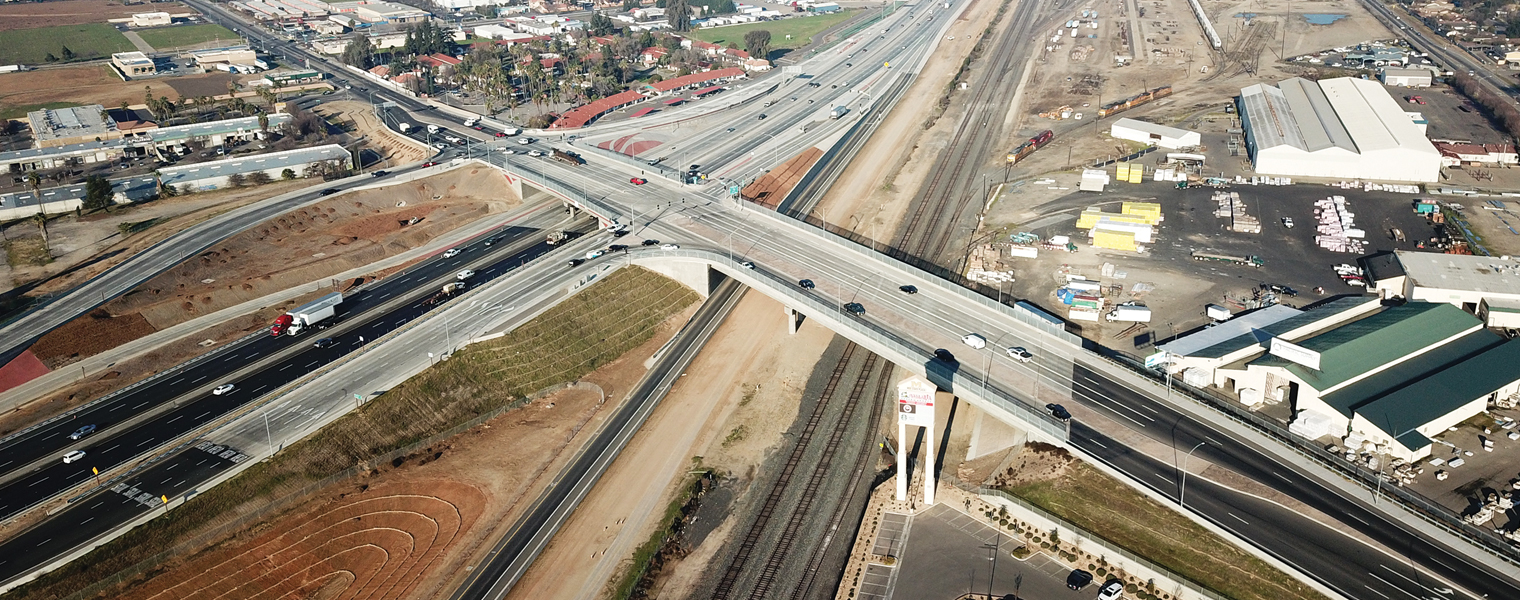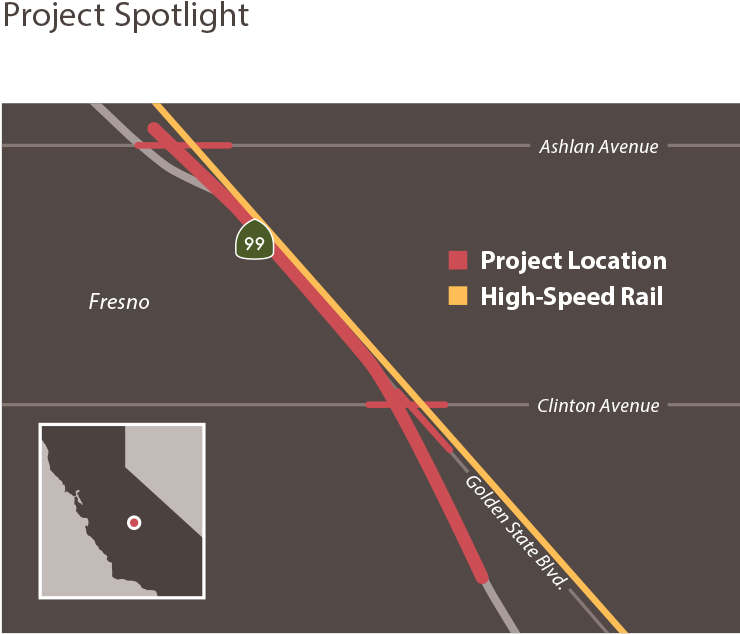New Life for Old Stretch of 99
Realignment of Busy Corridor Through Central Fresno Transformed Entire Area

Although it was moved to the west just 80 feet — a stone’s throw — realigning a two-mile stretch of State Route 99 in central Fresno was a massive undertaking that wound up being the largest state highway project ever in the region.
The 99 Realignment project was wrapped up in late 2018, with a formal ribbon-cutting dedicating the new highway section from Ashlan to Clinton avenues held in February 2019. Construction got underway in December 2015 after three years of planning and design spearheaded by Caltrans regional District 6.
The rerouting of SR 99 was done to accommodate the alignment of the California High-Speed Rail line through Fresno. Much of the work on the high-speed rail network intended to first serve the Central Valley has been centered in the Fresno area.
SR 99 is one of the state’s heavily traveled, and commercially important, corridors. The section of highway between Clinton and Ashlan avenues, the project area, accommodates an average of 114,000 vehicles a day, with trucks making up 17 percent of that traffic, according to 2019 Caltrans traffic counts.
The new section of highway replaced the original portion of SR 99 that hadn’t seen major improvements for at least 50 years.

The finished project delivers a vastly improved traveling experience on the highway known to many simply as “99.” Drivers now ride atop a smooth, long-life pavement in all three lanes in each direction. The 99 Realignment eliminated a cramped, outdated design, including three nonstandard partial interchanges built in an earlier era, and now features the latest advances in safety and traffic operations. It also eased gridlock along the highly congested east-west corridors at Clinton and Ashlan avenues.
The impact of the $290 million realignment reached far beyond the highway. An innovative design and procurement process allowed for a smaller route footprint with minimized impacts to the business community, and greatly enhanced the appeal of the area. The project improved the local circulation and accessibility for adjacent property owners, and injected a new vitality into surrounding neighborhoods and local businesses.
Inclusion of new landscaping, wider walking paths and bike paths in the project area also help make for a more livable urban core.
But before a new section of SR 99 and the high-speed rail network could be built, the Caltrans-led team faced a series of logistical hurdles. Apart from the obvious traffic issues, the Ashlan to Clinton segment of 99 passes through a major urban location, surrounded by dozens of businesses that would be impacted by the realignment, and thousands of nearby residents who crossed the highway overpasses.
A revamped road-rail corridor also presented major engineering issues, accompanied by the question of how to best schedule the work and traffic mitigations to keep the project on schedule. Relocation of major utility connections were required. And multiple stakeholders were involved, each of whom had to be consulted and involved in the decision-making process.
Perhaps the most formidable challenge came with the reconstruction of the Clinton Avenue interchange.
Initial scheduling showed a lengthy construction timeline of 18 to 24 months to transform the interchange due to a phased construction approach, utility relocations, and right of way acquisitions. Given those constraints, it became clear the realignment of SR 99 and the Clinton interchange reconstruction needed to occur simultaneously if delivery of the project was to occur within a more ambitious schedule.
The Caltrans team and project partners sorted through the options and chose a bold but potentially unpopular approach — closing the busy Clinton overcrossing altogether. The move would shave the overcrossing construction time to seven months by giving crews unfettered 24-hour/seven-day-a-week access to the site, but close off a key interchange and cut off east-west access over the highway for residents and businesses.
The closure proposal also relied on an extensive detour plan and outreach campaign, and buy-in from a diverse range of stakeholders that included the city of Fresno, Union Pacific Railroad, multiple utility companies, schools and businesses. To keep from cutting off the community, a dedicated bus service to carry people across the Clinton overpass seven days a week also was launched.
The plan went into effect in April 2017. Executed by Granite Construction — the prime contractor brought on board early in the project — the overcrossing work was completed within the promised seven-month timetable.
The 99 Realignment team also had to work with numerous businesses that would be affected along the project’s two-mile path. The acquisition process involved 42 business properties, and the negotiations were often arduous and required creative solutions. In the case of the Fresno Rescue Mission, and the former Hacienda Hotel, a historic Fresno landmark, plan redesigns were made that enabled both to continue operations and allow highway construction to proceed, without incurring extra costs.
The realignment project was financed through the California High-Speed Rail Authority. Through careful budgeting, time and materials savings, and early involvement of Granite Construction in the planning process, the project is expected to be within its $290 million budget.
Altogether, about 700 Caltrans staff members helped lay the groundwork for the project prior to construction, which began after completion of an environmental review in 2013. The realignment also proved to be a boon for the regional economy, employing more than 1,750 persons during the construction phase. About 75 percent of those workers came from the Central Valley.
The project team also developed a small business and subcontracting plan that ultimately contracted with 56 small businesses, accounting for 31.5 percent of the work that met the hiring requirements for National Targeted and Disadvantaged Workers as called for in the High-Speed Rail Authority build contract.
The SR 99 realignment is part of the overall improvement that has taken place on the busy highway in the last decade. Much of SR 99 through the Central Valley has been upgraded to three lanes in each direction, creating safer and smoother conditions for travelers.

Source: Garth Fernandez, Caltrans Senior Transportation Engineer, Realign 99 Project Manager.
Sustainable Practices Minimize Project’s Environmental Impact
On the 99 Realignment project, every effort was made to use sustainable practices to conserve resources and preserve the environment in keeping with Caltrans’ Strategic Management Plan goals of sustainability and efficiency.

Among the construction materials savings:
- 75,000 tons of existing asphalt surfacing were recycled into hot mix asphalt or roadway bases.
- 45,000 cubic yards of existing concrete were recycled into roadway base.
- 500 tons of steel were recycled for commercial reuse.
- The project also utilized selected on-site materials and performed on-site material blending when necessary to create structure backfill material, meeting the contract quality requirements. This approach reduced the use of virgin aggregates, and lowered tailpipe emissions by limiting project trucking requirements.
As part of sustainable landscaping practices, the rebuilt two-mile stretch features drought-tolerant plants and will be able to use recycled water from the city of Fresno when it becomes available.
A commitment was made as well to air quality standards during construction. A voluntary emissions reduction agreement was made between the High-Speed Rail Authority and the San Joaquin Valley Air Pollution Control District to use the cleanest, most reasonably available off-road equipment and on-road equipment consisting of an average fleet mix of equipment of model year 2010 or newer, to the extent reasonably practical.

